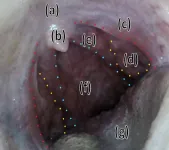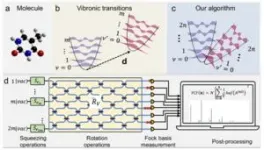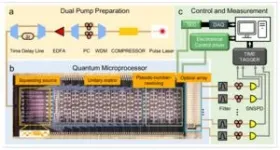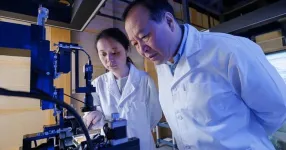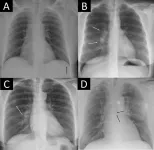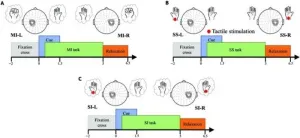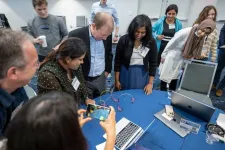(Press-News.org)
The rise in the incidence of oropharyngeal squamous cell carcinomas (OPSCCs) linked to human papillomavirus (HPV)-16 infection has become notable, surpassing cervical high-risk HPV infections by 2019. HPV-associated OPSCCs present a better prognosis compared to traditional oropharyngeal malignancies, largely due to lower correlations with chronic tobacco and alcohol use. Despite the sexually transmitted nature of HPV-associated OPSCCs, data on sexual behaviors is sparse in cancer registries, complicating correlation studies. Notably, high-risk factors in men include recent same-sex sexual activity, with significant odds ratios noted in studies. This context underscores the need for accessible and effective screening tools to manage the increasing OPSCC burden, especially in resource-limited settings.
Materials and Methods
In this study, the feasibility of using low-cost videoscopes to obtain high-quality "oral selfies" for OPSCC screening was examined. The equipment included a $30 Depstech 86T industrial videoscope, known for its waterproof capability and high resolution, connected to a Windows PC laptop. The participants, familiar with the project, were instructed to record a 20-30 second video of their oropharynx. The setup involved positioning the videoscope's head between the maxillary central incisors and capturing all anatomical landmarks. The videoscope’s ability to provide clear images of the oropharyngeal region was assessed through these recorded videos.
Results
Two sub-studies were conducted to evaluate the practicality and effectiveness of the videoscope. In the first sub-study, five volunteers recorded videos, with an average time of 36 seconds to capture all necessary landmarks. Feedback from a focus group highlighted the ease of use, the novelty of viewing one's oropharynx, and the need for proper orientation of the videoscope. Marking the scope's top and initial practice were recommended for better results. The primary barrier was controlling tongue position, critical for clear visibility of the palatine tonsils. Nevertheless, the videos produced were of sufficient quality for diagnostic purposes. Participants reported that while the process was initially challenging, they quickly adapted and found the task manageable.
The second sub-study involved nine participants who successfully recorded their oropharynx videos, which were then graded on clarity and completeness. The average score was 3.1 on a 5-point scale, indicating that most videos provided a reasonably clear view of the oropharynx. This sub-study reinforced the initial findings on the practicality and quality of using videoscopes for this purpose. Reviewers noted that although some videos were not perfect, the overall quality was acceptable for screening purposes. The videos were evaluated based on several criteria including lighting, focus, and the visibility of critical anatomical features.
Discussion
The data suggest that commercially available videoscopes, coupled with laptops, can effectively produce clear and well-lit videos of the oropharynx. The primary challenge remains the control of tongue positioning to avoid obstruction of key anatomical features. Despite this, the study demonstrates that with proper guidance and practice, individuals can use these low-cost devices to obtain videos suitable for screening OPSCCs. The ease of use and affordability of the videoscopes make them a promising tool for widespread screening, particularly in low-resource settings where traditional medical imaging equipment may not be available. The study also highlights the potential for telemedicine applications, where these videos could be reviewed by specialists remotely.
Conclusions
This study supports the potential of low-cost videoscopes as a viable tool for screening HPV-associated oropharyngeal cancers. The ease of use and ability to capture diagnostic-quality images highlight their promise, especially with appropriate user training to overcome initial barriers like tongue control. Further large-scale studies are warranted to solidify these findings and integrate this technology into regular screening practices. The implementation of such low-cost screening tools could significantly enhance the early detection and management of OPSCCs, ultimately improving patient outcomes and reducing healthcare costs.
Full text
https://www.xiahepublishing.com/2835-3315/CSP-2024-00005
The study was recently published in the Cancer Screening and Prevention.
Cancer Screening and Prevention (CSP) publishes high-quality research and review articles related to cancer screening and prevention. It aims to provide a platform for studies that develop innovative and creative strategies and precise models for screening, early detection, and prevention of various cancers. Studies on the integration of precision cancer prevention multiomics where cancer screening, early detection and prevention regimens can precisely reflect the risk of cancer from dissected genomic and environmental parameters are particularly welcome.
Follow us on X: @xiahepublishing
Follow us on LinkedIn: Xia & He Publishing Inc.
END
Quantum simulation enables scientists to simulate and study complex systems that are challenging or even impossible using classical computers across various fields, including financial modelling, cybersecurity, pharmaceutical discoveries, AI and machine learning. For instance, exploring molecular vibronic spectra is critical in understanding the molecular properties in molecular design and analysis. However, it remains a long-standing computationally difficult problem that cannot be efficiently solved using traditional super-computers. Researchers are diligently working on quantum computers and algorithms to ...
INDIANAPOLIS – A new study examining older Black Americans’ perceptions of Alzheimer’s disease has found a lack of awareness of the devastating condition. The authors propose strategies for supporting brain health in this population.
Absence of awareness of Alzheimer's disease may undermine Black Americans’ ability to identify potential risk of the disease and its impact on their community, said Johanne Eliacin, PhD, Regenstrief Institute, U.S. Department of Veterans Affairs and the Indiana University School of Medicine research scientist and study leader. ...
OAK BROOK, Ill. – A commercial artificial intelligence (AI) tool used off-label was effective at excluding pathology and had equal or lower rates of critical misses on chest X-ray than radiologists, according to a study published today in Radiology, a journal of the Radiological Society of North America (RSNA).
Recent developments in AI have sparked a growing interest in computer-assisted diagnosis, partly motivated by the increasing workload faced by radiology departments, the global shortage of radiologists and the potential for burnout in the field. Radiology practices have a high volume of unremarkable ...
The field of precision medicine, especially in the context of cancer immunotherapy, has seen significant advancements in recent years. Precision medicine tailors treatment to the unique genetic and molecular profile of each patient, moving away from conventional one-size-fits-all approaches. This personalized strategy aims to minimize side effects and maximize therapeutic efficacy. A key component of this approach is the use of immune checkpoint inhibitors (ICIs), monoclonal antibodies that target immunosuppressive molecules such as PD-1, PD-L1, and CTLA-4. These ICIs have demonstrated considerable ...
In a groundbreaking study recently published, researchers from Zhejiang University have unveiled significant findings that could enhance brain-computer interface (BCI) technologies, marking a crucial step towards more intuitive neuroprosthetic control and advanced rehabilitation therapies. The study, titled "Neural Correlates of Motor/Tactile Imagery and Tactile Sensation in a BCI paradigm: A High-Density EEG Source Imaging Study," employed high-density electroencephalogram (EEG) recordings to delve into the neural dynamics of motor and ...
MIAMI (August 20, 2024) – Inhaler misuse leading to inadequate medication delivery impacts a person’s ability to manage symptoms of chronic obstructive pulmonary disease (COPD), and additional education about proper inhaler use is needed to improve health outcomes, according to two new articles. The articles are published in the July 2024 issue of Chronic Obstructive Pulmonary Diseases: Journal of the COPD Foundation, a peer-reviewed, open-access journal.
COPD comprises several conditions, including chronic bronchitis and emphysema, and can be caused by irritants like smoke or pollution and genetics. The disease affects more than 30 ...
During a pandemic, attention is usually focused on the immediate challenges, such as managing the disease, ensuring safety and coping with disruptions in daily routines. Adversity, while difficult, can sometimes lead to positive effects.
For older adults living in retirement communities, there has been limited research on how the COVID-19 pandemic and its regulatory measures affected them. Additionally, there is scant research on any potential positive effects for this population.
Now, a new study of 98 older adults (median age 86 years) living in a continuing care retirement community in South Florida during COVID-19 reveals ...
UTSA will partner with Texas A&M University to co-lead SECURE Southwest, one of five new regional centers being launched to strengthen U.S. research security.
Under a five-year, $67 million award from the National Science Foundation (NSF), the Safeguarding the Entire Community of the U.S. Research Ecosystem (SECURE) Center aims to strengthen intellectual property and research security by educating members of the research community about security issues and engaging them in a process of collaborative problem-solving.
The ...
A widely used security protocol that dates back to the days of dial-up Internet has vulnerabilities that could expose large numbers of networked devices to an attack and allow an attacker to gain control of traffic on an organization's network.
A research team led by University of California San Diego computer scientists investigated the Remote Authentication Dial-In User Service (RADIUS) protocol and found a vulnerability they call Blast-RADIUS that has been present for decades. RADIUS, designed in 1991, allows networked devices such as routers, switches or mobile roaming gear to use a remote server to validate login or other credentials.
This is a common set-up in enterprise and ...
A study of children’s conversations with their caretakers sheds light on the timeline of the emergence of moral foundation words in the first six years of life in English-speaking children. Moral Foundations theory posits that morality is largely intuitive and underlaid by modular foundations. The original set of five foundations proposed by researchers includes Care/Harm, Fairness/Cheating, Authority/Subversion, Loyalty/Betrayal, and Purity/Degradation. Aida Ramezani and colleagues systematically ...
